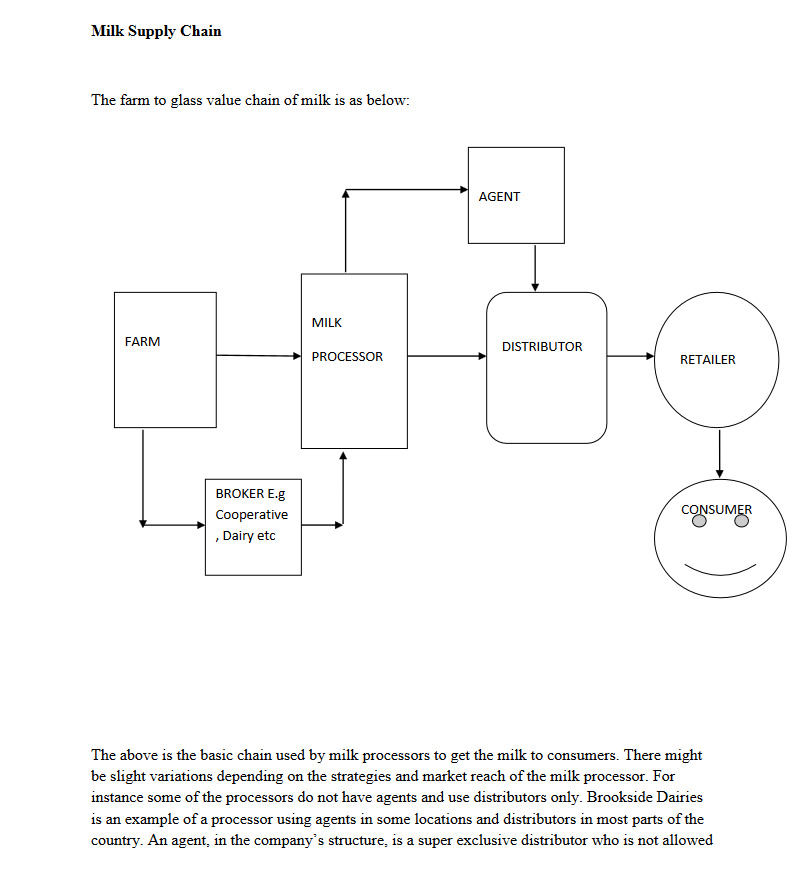Milk Distributorship & Industry Business Plan
Milk Distributorship & Industry Business Plan

Milk Distributorship & Industry Business Plan Overview
This Milk Distributorship & Industry Business Plan refers to the business of a distributor who is the link between the milk processor and the retailer. Or if considered in the larger context he links the processor with the consumer.
The greatest strength a distributor has and which makes the processor partner with him is his understanding of the local market. The distributor is presumed to know the inside and out of the local market in terms of location of retail outlets, retailer behavior, consumer behavior and size in addition to the ability to keep an eye on local trends that might affect milk consumption such as population growth and preferences. With this information he is supposed to form profitable partnerships with retailers, who in turn push the companies’ products to the consumer.
If as a distributor you are not able to form good working relationships with retailers you cannot succeed as a milk distributor. It does not matter whether the milk brand you are distributing is the strongest in the national market. Success in the business is to a large extent dependent on how you work the retailers.
Companies want growth, and for low margin Fast Moving Consumer Goods (FMCG) like milk growth comes from increased sales.. However companies don’t grow arbitrarily. They consider factors like their own capacity, behavior of competitors among others. For instance relatively small and low capitalized processors may not wish to grow very fast until they are able to increase their capacity (think machinery) to process more milk and more importantly until they are able to recruit more dairy farmers. They would be hesitant to get into a market only to develop a reputation of unreliable supplies. This is the reason some milk companies only supply milk to a few towns.
So if your location does not have a distributor of a particular brand it’s not necessarily because the company is not interested but it could be because its capacity does not allow. Of course the best way to find out is by approaching the company. It will be of help if you have an idea of the capacity/size of the company and most important you have hard figures on consumers, retailers, competitor behavior in your location. These can be just through observation. The aim is to convince the company of the existence of an opportunity if it hasn’t already seen it.
Nairobi is the biggest milk consumer, and if in an estate a particular brand does not have a distributor then a company will most likely respond favorably. On the other hand if you are located outside Nairobi say in Kerugoya and the milk company is located in Kiambu town and has not started selling in the region then they are not likely to start selling in the location just because you have proposed and an opportunity exists. They will consider the cost of delivering relatively few crates of milk from their factory to Kerugoya 100 kilometers away. But if they already delivering in Embu 30 kilometers from Kerugoya then it will make business sense to have a distributor in a nearby town.
To establish whether there is opportunity for distributorship look at the milk brands in the area. If one of the bigger brands is missing approach it first. If all the big brands are represented then you can approach the mid tier brands and then the smaller brands. You can start with those within reasonable distance of your location. Or those companies which pass through or near your town on their way to deliver to other possibly bigger towns.
As you will see below companies don’t just give you a distributorship and a freehand, they monitor you to make sure you are keeping to certain standards and meeting set targets. So they would like to have personnel in the region. Smaller companies operating in limited locations sometimes prefer not to have distributors opting to deal with retailers directly. Partially this is so that they can enjoy higher margins but most important is the need to have more control as they introduce their brands. Later when the brand is established they recruit distributors.
Download Milk Distributorship & Industry Business Plan / guide here